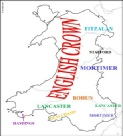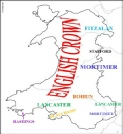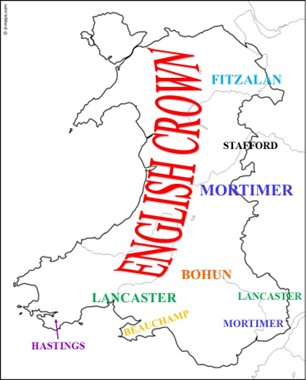1284  The Statute of Rhuddlan
The Statute of Rhuddlan
After Llywelyn ap Gruffudd and his brother, Dafydd, had been killed in 1282 and 1283, respectively, Edward I of England enacted the Statute of Rhuddlan in 1284. This was a government ordinance which introduced English laws into Cymru - although it did also allow the laws of Hywel Dda to be continued in some areas. This situation lasted until it was changed by Henry VIII of England in 1536.
The statute also introduced the English shire system into Cymru, with the counties of ‘Carnarvonshire’, ‘Carmarthenshire’, ‘Cardiganshire’ and others, being formed. The Marcher lords still controlled a large part of the country, however.
Edward I had begun the construction of his ‘iron ring of castles’ by this time and had started to enact harsh laws on the native population. This eventually led to a number uprisings:
1287 Rhys ap Maredudd
Rhys ap Maredudd of Deheubarth had supported Edward I during the war of independence of Llywelyn ap Gruffudd but, by 1287, he had become disgruntled with his treatment and rebelled against English rule. Rhys had captured most of Ystrad Tywi, including the castles at Dinefwr and Carreg Cennen, but he lost Castell Dryslwyn after it was besieged and then captured by Edward’s forces.
1288 Castell Newydd Emlyn
A few months later, Rhys ap Maredudd took Castell Newydd Emlyn but this was retaken by the English in early 1288 and he then went into hiding.
1291 Capture and execution of Rhys ap Maredudd
Rhys was eventually captured in 1291 and executed for treason at York shortly afterwards.
1294 Madog ap Llywelyn
In August 1294, a large number of the Cymry in Edward I’s army refused to obey the order to embark for Gascony in France. This led to the uprising of 1294 and became a serious challenge to English royal authority in Cymru. By October, most of Gwynedd was controlled by Madog ap Llywelyn - except for the castles - and there was a great deal of unrest around the country.
Madog was a descendant of Owain Gwynedd and the lords of Meirionydd; he led the campaign against English rule and claimed the title Tywysog Cymru. A number of other leaders rose up at the same time, including Cynan ap Maredudd in Brycheiniog, Maelgwyn ap Rhys in Ceredigion and Morgan ap Maredudd in Gwent.
1295 Battle of Carnedd Llywelyn
In order to counter the threat, Edward I led an army of 35,000 men into Gogledd Cymru to subdue the uprising. After spending the Christmas of 1294 at Castell Conwy, Edward and his army travelled to Bangor in early January 1295 but his baggage train was attacked at Penmaenmawr by Madog ap Llywelyn and his men, who were based on Carnedd Llywelyn.
1295 Siege of Castell Conwy and the battle of Cadnant
Edward I was then forced to return to Castell Conwy, and remained there under siege and with atrocious weather conditions that prevented a relief force from landing. The siege was eventually lifted by an English force led by William de Beauchamp, earl of Warwick around January 22nd. Beauchamp led his forces from the castle and defeated the Cymry at nearby Cadnant.
1295 Battle of Maes Maidog
A few weeks later, William de Beauchamp and his English army again faced the Cymry in battle, who were led by Madog ap Llywelyn. The battle of Maes Maidog took place three miles to the west of Y Trallwng (Welshpool) on March 5th, 1295, and ended in defeat for Madog. Although he escaped after the battle, Madog eventually surrendered to the English a few months later and was then imprisoned in the Tower of London, where he spent the rest of his life.
1316 Llywelyn Bren
Another uprising broke out in the south-east following the appointment of Payn de Turberville of Coety as royal custodian in Glamorgan. Llywelyn ap Gruffudd ap Rhys (or Llywelyn Bren), a descendant of Ifor Bach of Senghennydd, took exception to Turberville’s oppressive behaviour and, in January 1316, attacked Castell Carffili and put it under siege, burning the town around it.
1316 Castell Morgraig
Similar attacks then took place throughout De Cymru, and Edward II of England sent Humphrey de Bohun, earl of Hereford, to confront Llywelyn. In March 1316, Bohun and his army confronted the Cymry at Castell Morgraig, 5 miles to the north of Caerdydd, forcing Llywelyn to call off the siege at Caerffili and move northwards. When he realised that the fight was lost, Llywelyn surrendered at Ystradfellte and asked that only he should be punished for his actions and not his followers.
1318 Death of Llywelyn Bren
Llywelyn was then taken to the Tower of London before becoming the prisoner of Hugh, the Younger Despenser in 1318. Despenser had recently been appointed lord of Glamorgan and took Llywelyn to Castell Caerdydd, where he was hanged, drawn and quartered, with his body parts eventually being buried near the castle at Grey Friars.
1326 Return of Senghennydd estates
When Edward II was overthrown in 1326, however, Despenser suffered the same fate as Llywelyn, and the estates in Senghenydd were returned to Llywelyn’s sons.
The Black Death reached Europe in the mid-14th century and caused great social upheaval. A number of revolts took place in England and unrest also grew in Cymru.
1363 Owain Lawgoch
Rhodri ap Gruffudd, the brother of Llywelyn ap Gruffudd, gave up his claims to the throne of Gwynedd and moved to live at Tatsfield in the south-east of England. His grandson, Owain ap Tomas - or Owain Lawgoch as he would become known - was not happy with this situation, however. Owain had spent much of his childhood living in France under the protection of the king, Charles V, but when his father, Tomas, died in 1363, he was intent on claiming his inheritance. He eventually became a distinguished soldier fighting for Charles against Edward III of England in the Hundred Years War.
1369/1372 Tywysog Cymru
Owain Lawgoch made two attempts to return to Cymru to claim his inheritance as Tywysog Cymru. In 1369, he commanded a fleet that left France to sail to Cymru but a great storm forced him to return to port, and in 1372 he made another attempt but only got as far as Guernsey before Charles V instructed him to sail to Castile instead.
1378 Assassination of Owain Lawgoch
Owain was apparently planning to travel to Cymru again in 1378 when he was assassinated by a spy, John Lamb, in Mortagne-sur-Gironde, on the orders of Edward III’s brother, John of Gaunt. The bards told stories of Owain’s exploits as they travelled around Cymru, and they may well have influenced his distant cousin, Owain Glyndŵr.
1400-1404 Owain Glyndŵr
Glyndŵr’s War for Independence began in 1400 at Glyndyfrdwy in north-east Cymru and, by the end of 1403, he controlled the whole of Cymru. He held his first parliament at Machynlleth in 1404 and made Castell Harlech his family home shortly afterwards.
1405 Turning point of uprising
The crucial point in Owain’s campaign came in August 1405 when, with the assistance of a large army from France, he confronted Henry IV of England near Worcester. The result was a stalemate and both sides retreated, but the uprising then began to wane.
1415 Death of Glyndŵr
Harlech fell to the English in 1409, and Glyndŵr stepped down from leading the campaign in 1412 when his son, Maredudd, took over. It is thought that Owain died in Herefordshire in 1415, but the uprising continued until Maredudd finally accepted a pardon from Henry V of England in 1421.
* For much more information about Owain Glyndŵr, see our main website *



